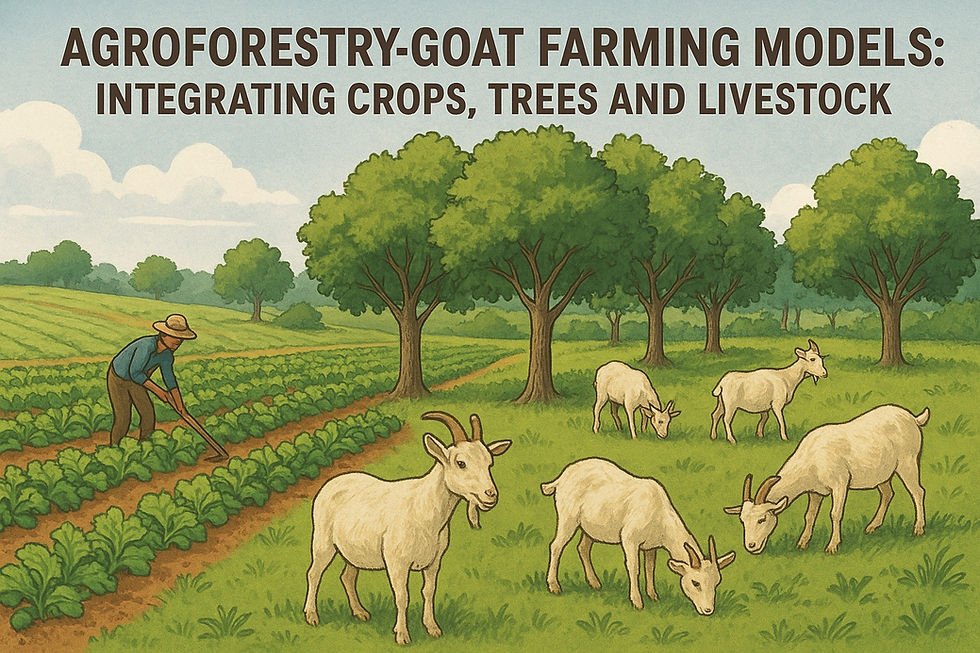Beyond the Barn: How Small Livestock Can Contribute to India’s Net Zero Goals
- Global Services TGT
- May 20
- 3 min read
Updated: Jun 11
As the world accelerates efforts to address climate change, India has pledged to achieve net-zero carbon emissions by 2070. Much of the focus has been on energy, transportation, and industrial sectors. However, agriculture—contributing over 14% of India’s greenhouse gas emissions—also holds significant opportunities for mitigation, especially within livestock systems. While cattle often dominate climate discussions, small livestock, such as goats, sheep, and poultry, are uniquely positioned to play a meaningful, low-cost role in India’s path to net zero, particularly in rural and resource-constrained communities.
The Overlooked Emissions of Small Livestock: Small livestock contribute to emissions primarily through:
Enteric fermentation in ruminants (e.g., goats, sheep) produces methane.
Manure management can release both methane and nitrous oxide.
Feed production, which may involve land-use change and fertilizer use.
Though per-animal emissions are lower than those from cattle, the high number of small livestock in India—over 148 million goats and 74 million sheep—means their cumulative impact is notable, particularly in dryland areas where grazing is extensive.
Small Livestock: Low Emissions, High Potential: Despite their emissions, small livestock offer a number of climate-smart advantages:
Lower Carbon Footprint per Unit of Output: Goats and chickens require less feed and water than large ruminants and can thrive on marginal land and by-products.
Adaptability to Climate Stress: Small ruminants are more drought-resistant and heat-tolerant than cattle, making them ideal for climate-resilient livelihoods.
Integration into Circular Farming Systems: Their manure can be composted or used in biogas plants, reducing reliance on synthetic fertilizers and fossil fuels.
Pathways to Emission Reduction and Net Zero Alignment: Several strategies can reduce the emissions of small livestock systems while aligning them with India’s broader climate goals:
1. Improved Feeding Practices
Better feed quality reduces enteric methane production and improves growth efficiency.
Crop residues and legume fodders can be utilized to create low-emission feed options.
2. Manure Management Innovations
Composting or using biodigesters prevents methane emissions from unmanaged waste.
Treated manure also enhances soil health and carbon sequestration.
3. Breed Improvement
Cross-breeding for disease resistance and higher productivity leads to fewer animals needed per unit of output.
4. Agroforestry and Silvopasture
Integrating trees with grazing systems sequesters carbon, improves biodiversity, and reduces pressure on forests.
Policy and Carbon Market Opportunities: To unlock the full mitigation potential, climate finance mechanisms must be made accessible to small livestock keepers.
Carbon credit markets can reward emission reductions from improved livestock practices.
Results-based finance through international climate funds (e.g., GCF, Adaptation Fund) can support pro-poor, livestock-based climate interventions.
National programs, such as the National Action Plan on Climate Change (NAPCC) and the National Livestock Mission (NLM), can integrate small livestock into mitigation frameworks.
Socioeconomic Co-Benefits: Integrating small livestock into climate action has ripple effects beyond emissions:
Nutritional security through increased access to milk, eggs, and meat.
Gender empowerment, as women often manage small livestock, gaining income and decision-making power.
Resilient livelihoods for landless and marginal farmers who rely on livestock during climate-induced crop failures.
Challenges to Address: To scale up the climate contribution of small livestock, India must address:
Limited data on emissions and mitigation outcomes at the smallholder level.
Weak veterinary infrastructure and low extension outreach.
Lack of awareness about the climate-livestock nexus among policymakers and rural communities.
Market barriers in monetizing emission reductions through carbon trading.
India’s climate ambitions must be rooted in inclusive, rural-centric solutions. While small livestock may not carry the emissions burden of industry or fossil fuels, their role in shaping a just and resilient low-carbon future is undeniable. Through sustainable practices, carbon market access, and supportive policies, goats and chickens may prove to be unexpected allies in India’s journey beyond the barn and toward net zero.



Comments